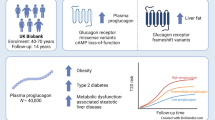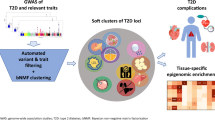Abstract
Hepatic gene expression is known to differ between healthy and type 2 diabetes conditions. Identifying these variations will provide better knowledge to the development of gene-targeted therapies. The aim of this study is to assess diet-induced hepatic gene expression of susceptible versus resistant CC lines to T2D development. Next-generation RNA-sequencing was performed for 84 livers of diabetic and non-diabetic mice of 41 different CC lines (both sexes) following 12 weeks on high-fat diet (42% fat). Data analysis revealed significant variations of hepatic gene expression in diabetic versus non-diabetic mice with significant sex effect, where 601 genes were differentially expressed (DE) in overall population (males and females), 718 genes in female mice, and 599 genes in male mice. Top prioritized DE candidate genes were Lepr, Ins2, Mb, Ckm, Mrap2, and Ckmt2 for the overall population; for females-only group were Hdc, Serpina12, Socs1, Socs2, and Mb, while for males-only group were Serpine1, Mb, Ren1, Slc4a1, and Atp2a1. Data analysis for sex differences revealed 193 DE genes in health (Top: Lepr, Cav1, Socs2, Abcg2, and Col5a3), and 389 genes DE between diabetic females versus males (Top: Lepr, Clps, Ins2, Cav1, and Mrap2). Furthermore, integrating gene expression results with previously published QTL, we identified significant variants mapped at chromosomes at positions 36–49 Mb, 62–71 Mb, and 79–99 Mb, on chromosomes 9, 11, and 12, respectively. Our findings emphasize the complexity of T2D development and that significantly controlled by host complex genetic factors. As well, we demonstrate the significant sex differences between males and females during health and increasing to extent levels during disease/diabetes. Altogether, opening the venue for further studies targets the discovery of effective sex-specific and personalized preventions and therapies.






Similar content being viewed by others
Data availability
All raw data and statistical results are available upon request from the authors.
References
Abu-Toamih Atamni HJ, Botzman M, Mott R, Gat-Viks I, Iraqi FA (2016a) Mapping liver fat female-dependent quantitative trait loci in collaborative cross mice. Mamm Genome 27(11–12):565–573
Abu-Toamih Atamni HJ, Mott R, Soller M, Iraqi FA (2016b) High-fat-diet induced development of increased fasting glucose levels and impaired response to intraperitoneal glucose challenge in the collaborative cross mouse genetic reference population. BMC Genet 17:10
Abu-Toamih Atamni HJ, Ziner Y, Mott R, Wolf L, Iraqi FA (2017) Glucose tolerance female-specific QTL mapped in collaborative cross mice. Mamm Genome 28(1–2):20–30
Abu-Toamih Atamni HJ, Botzman M, Mott R, Gat-Viks I, Iraqi FA (2018) Mapping novel genetic loci associated with female liver weight variations using collaborative cross mice. Anim Model Exp Med. 1(3):212–220
Ansorge WJ (2009) Next-generation DNA sequencing techniques. N Biotechnol 25(4):195–203
Ashburner M, Ball CA, Blake JA, Botstein D, Butler H, Cherry JM, Davis AP, Dolinski K, Dwight SS, Eppig JT et al (2000) Gene ontology: tool for the unification of biology. The Gene Ontology Consortium. Nat Genet 25:25–29
Chan KH, Chacko SA, Song Y, Cho M, Eaton CB, Wu WC (2015) Genetic variations in magnesium-related ion channels may affect diabetes risk among African American and Hispanic American women. J Nutr 145(3):418–424
Chen X, Larson CS, West J, Zhang X, Kaufman DB (2010) In vivo detection of extrapancreatic insulin gene expression in diabetic mice by bioluminescence imaging. PLoS ONE 5(2):e9397
Clayton JA, Collins FS (2014) Policy: NIH to balance sex in cell and animal studies. Nature 509:282–283
Clee SM, Attie AD (2007) The genetic landscape of type 2 diabetes in mice. Endocr Rev 28(1):48–83 Review
Do OH, Gunton JE, Gaisano HY, Thorn P (2016) Changes in beta cell function occur in prediabetes and early disease in the Lepr (db) mouse model of diabetes. Diabetologia 59(6):1222–1230
Falls JG, Blake BL, Cao Y, Levi PE, Hodgson E (1995) Gender differences in hepatic expression of flavin-containing monooxygenase isoforms (FMO1, FMO3, and FMO5) in mice. J Biochem Toxicol 10(3):171–177
Fülöp AK, Földes A, Buzás E, Hegyi K, Miklós IH, Romics L (2003) Hyperleptinemia, visceral adiposity, and decreased glucose tolerance in mice with a targeted disruption of the histidine decarboxylase gene. Endocrinology 144(10):4306–4314
Gale EA, Gillespie KM (2001) Diabetes and gender. Diabetologia 44(1):3–15 Review
Iraqi FA, Mahajne M, Salaymah A et al (2012) The Genome architecture of the collaborative cross mouse genetic reference population. Genetics 190(2):389–402
Jin R, Krasinskas A, Le NA, Konomi JV, Holzberg J, Romero R (2018) Association between plasminogen activator inhibitor-1 and severity of liver injury and cardiovascular risk in children with non-alcoholic fatty liver disease. Pediatr Obes 13(1):23–29
Joost HG, Schürmann A (2014) The genetic basis of obesity-associated type 2 diabetes (diabesity) in polygenic mouse models. Mamm Genome 25(9–10):401–412
Kamburov A, Stelzl U, Lehrach H, Herwig R (2012) The consensus path DB interaction database: 2013 update. Nucleic Acids Res 41:D793–D800
Kaul N, Ali S (2016) Genes, genetics, and environment in type 2 diabetes: implication in personalized medicine. DNA Cell Biol 35(1):1–12 Review
Kojima H, Fujimiya M, Matsumura K, Nakahara T, Hara M, Chan L (2004) Extrapancreatic insulin-producing cells in multiple organs in diabetes. Proc Natl Acad Sci USA 101(8):2458–2463
Kontogianni, G., Papadodima, O., Mitrakas, A., et al. (2017) An RNA-seq analysis from non-small cell lung cancer biopsies suggests an important role for aberrant alternative splicing in its pathophysiology. Health and Technology, 1-8
Kumar R, Mota LC, Litoff EJ et al (2017) Compensatory changes in CYP expression in three different toxicology mouse models: CAR-null, Cyp3a-null, and Cyp2b9/10/13-null mice. PLoS ONE 12(3):e0174355
Lebrun P, Van Obberghen E (2008) SOCS proteins causing trouble in insulin action. Acta Physiol (Oxf) 192(1):29–36 Review
Legato MJ, Gelzer A, Goland R, Ebner SA, Rajan S, Villagra V (2006) Gender-specific care of the patient with diabetes: review and recommendations. Gend Med 3(2):131–158 Review
Masuzaki R, Zhao S, Valerius MT, Tsugawa D, Oya Y, Ray KC (2016) SOCS2 Balances metabolic and restorative requirements during liver regeneration. J Biol Chem 291(7):3346–3358
Mathers CD, Loncar D (2006) Projections of global mortality and burden of disease from 2002 to 2030. PLoS Med 3(11):e442
Nachshon A, Abu-Toamih Atamni HJ, Steuerman Y et al (2016) Dissecting the effect of genetic variation on the hepatic expression of drug disposition genes across the collaborative cross mouse strains. Front Genet 7:172
Nashef A, Abu-Toamih Atamni HJ, Buchnik Y et al (2017) Collaborative cross mouse population for studying alveolar bone changes and impaired glucose tolerance comorbidity after high-fat diet consumption. J Periodontol 88(9):e150–e158
Nashef A, Qabaja R, Salaymeh Y et al (2018) Integration of murine and human studies for mapping periodontitis susceptibility. J Dent Res 97(5):537–546
Ng SB, Buckingham KJ, Lee C et al (2010) Exome sequencing identifies the cause of a Mendelian disorder. Nat Genet 42(1):30–35
Nitta T, Xundi X, Hatano E et al (2003) Myoglobin gene expression attenuates hepatic ischemia reperfusion injury. J Surg Res 110(2):322–331
Parikh A, Stephan AF, Tzanakakis ES (2012) Regenerating proteins and their expression, regulation and signaling. Biomol Concepts 3(1):57–70
Rossner R, Kaeberlein M, Leiser SF (2017) Flavin-containing monooxygenases in aging and disease: emerging roles for ancient enzymes. J Biol Chem 292(27):11138–11146 Review
Samsom M, Trivedi T, Orekoya O, Vyas S (2016) Understanding the importance of gene and environment in the etiology and prevention of type 2 diabetes mellitus in high-risk populations. Oral Health Case Rep 2(1):112
Schlieper G, Kim JH, Molojavyi A et al (2004) Adaptation of the myoglobin knockout mouse to hypoxic stress. Am J Physiol Regul Integr Comp Physiol 286(4):R786–R792
Shen J, Zhu B (2018) Integrated analysis of the gene expression profile and DNA methylation profile of obese patients with type 2 diabetes. Mol Med Rep 17:7636–7644
Shusterman A, Munz M, Richter G et al (2017) The PF4/PPBP/CXCL5 gene cluster is associated with periodontitis. J Dent Res 96(8):945–952
Smith CL, Eppig JT (2009) The mammalian phenotype ontology: enabling robust annotation and comparative analysis. Wiley Interdiscip Rev 1:390–399
Takamura T, Sakurai M, Ota T, Ando H, Honda M, Kaneko S (2004) Genes for systemic vascular complications are differentially expressed in the livers of type 2 diabetic patients. Diabetologia 47(4):638–647
Templeman NM, Mehran AE, Johnson JD (2016) Hyper-variability in circulating insulin, high fat feeding outcomes, and effects of reducing Ins2 dosage in male Ins1-null mice in a specific pathogen-free facility. PLoS ONE 11(4):e0153280
Trapnell C, Roberts A, Goff L, Pertea G, Kim D, Kelley DR (2012) Differential gene and transcript expression analysis of RNA-seq experiments with TopHat and Cufflinks. Nat Protoc 7(3):562–578
Ueki K, Kondo T, Tseng YH, Kahn CR (2004) Central role of suppressors of cytokine signaling proteins in hepatic steatosis, insulin resistance, and the metabolic syndrome in the mouse. Proc Natl Acad Sci USA 101(28):10422–10427
Voelkerding KV, Dames SA, Durtschi JD (2009) Next-generation sequencing: from basic research to diagnostics. Clin Chem 55(4):641–658 Review
Wiwi CA, Gupte M, Waxman DJ (2004) Sexually dimorphic P450 gene expression in liver-specific hepatocyte nuclear factor 4alpha-deficient mice. Mol Endocrinol 18(8):1975–1987
World Health Organization (2014) Global status report on noncommunicable diseases 2014. WHO. http://www.who.int/nmh/publications/ncd-status-report-2014/en/. Accessed 25 Nov 2015
Xie G, Wang X, Zhao A et al (2017) Sex-dependent effects on gut microbiota regulate hepatic carcinogenic outcomes. Sci Rep 7:45232
Yang X, Schadt EE, Wang S, Wang H, Arnold AP, Ingram-Drake L (2006) Tissue-specific expression and regulation of sexually dimorphic genes in mice. Genome Res 16(8):995–1004
Zadjali F, Santana-Farre R, Vesterlund M, Carow B, Mirecki-Garrido M, Hernandez-Hernandez I (2012) SOCS2 deletion protects against hepatic steatosis but worsens insulin resistance in high-fat-diet-fed mice. FASEB J 26(8):3282–3291
Zhang JG, Metcalf D, Rakar S, Asimakis M, Greenhalgh CJ, Willson TA (2001) The SOCS box of suppressor of cytokine signaling-1 is important for inhibition of cytokine action in vivo. Proc Natl Acad Sci USA 98(23):13261–13265
Acknowledgements
Sequencing and primary data quality control was performed at the Genomics Unit of the Centre for Genomic Regulation (CRG) in Barcelona, Spain, with the support of European Sequencing and Genotyping Infrastructure (ESGI) Consortium. We thank Tel-Aviv University for core funding and technical support.
Funding
This work was supported by the Hendrech and Eiran Gotwert Fund for studying diabetes, Wellcome Trust grants 085906/Z/08/Z, 075491/Z/04, Wellcome Trust core funding Grant 090532/Z/09/Z, and core funding by Tel-Aviv University. The work leading to these results has received funding from the European Union Seventh Framework Programme (FP7/2007-2013) under Grant Agreement n° 262055 (ESGI).
Author information
Authors and Affiliations
Corresponding author
Ethics declarations
Conflict of interests
There are no competing financial interests in relation to the work described by all authors, including e/NIOS Company.
Additional information
Publisher's Note
Springer Nature remains neutral with regard to jurisdictional claims in published maps and institutional affiliations.
Electronic supplementary material
Below is the link to the electronic supplementary material.
Rights and permissions
About this article
Cite this article
Abu-Toamih Atamni, H.J., Kontogianni, G., Binenbaum, I. et al. Hepatic gene expression variations in response to high-fat diet-induced impaired glucose tolerance using RNAseq analysis in collaborative cross mouse population. Mamm Genome 30, 260–275 (2019). https://doi.org/10.1007/s00335-019-09816-1
Received:
Accepted:
Published:
Issue Date:
DOI: https://doi.org/10.1007/s00335-019-09816-1




